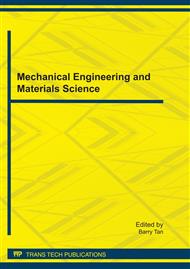[1]
Wuling Qiu, Huizhi Zhang. Chinese Fruit Tree[M]. Beijing: Forestry Publisher of China. 1996, pp.99-104.
Google Scholar
[2]
Hamgjun Chen, Haiyan Gao, Jinlin Mao et al. Changes of storage property and quality of different kinds of loquat fruit under low temperature [J]. Zhejiang Agricultural Transaction, 2007, 19( 4): pp.280-283.
Google Scholar
[3]
Lu ZM, Zhang ZL, Wu WX, et al. Effect of Low Temperatures on Postharvest Loquat Fruit[A]. Acta Horticulturae, 2007, No. 750. pp.483-486.
DOI: 10.17660/actahortic.2007.750.77
Google Scholar
[4]
Jingcheng Wu, Zhaohui Tang, Qun Chen et al. Effects of different storage temperatures on lignification and related enzyme activity of loquat[J]. WuHan Botany Research, 2006, 24( 3). pp.235-239.
Google Scholar
[5]
Chong Cai, ChangJie Xu, LanLan Shan, et al. Low temperature conditioning reduces postharvest chilling injury in loquat fruit[J]. Postharvest Biology and Technology, 41 (2006) p.252–259.
DOI: 10.1016/j.postharvbio.2006.04.015
Google Scholar
[6]
Chang-Kui Ding, Kazuo Chachin, Yasunori Hamauzu, et al. Effects of storage temperatures on physiology and quality of loquat fruit[J]. Postharvest Biology and Technology 14 (1998) p.309–315.
DOI: 10.1016/s0925-5214(98)00053-2
Google Scholar
[7]
Shaolan Yang, Chongde Sun, Ping Wang, et al. Expression of expansin genes during postharvest lignification and softening of Luoyangqing' and 'Baisha, loquat fruit under different storage conditions[J]. Postharvest Biology and Technology, 49 (2008).
DOI: 10.1016/j.postharvbio.2008.01.005
Google Scholar
[8]
Zhansheng Ding, Shiping Tian, Yousheng Wang, et al. Physiological response of loquat fruit to different storage conditions and its storability[J]. Postharvest Biology and Technology 41 (2006) p.143–150.
DOI: 10.1016/j.postharvbio.2006.03.012
Google Scholar
[9]
Chang-Kui Ding, Kazuo Chachin, Yoshinori Ueda, et al. Modified atmosphere packaging maintains postharvest quality of loquat fruit[J]. Postharvest Biology and Technology 24 (2002) p.341–348.
DOI: 10.1016/s0925-5214(01)00148-x
Google Scholar
[10]
Chen Fahe, Wu Guangbin, Li Chenfen. Effects of modified atmosphere packaging on respiration and quality attributes of loquat fruit during cold storage[J]. agricultural engineering journal, 2003, 19(5). pp.147-151.
Google Scholar
[11]
Amoros A, Pretel MT, Zapata PJ, et al. Use of modified atmosphere packaging with microperforated polypropylene films to maintain postharvest loquat fruit quality[J]. FOOD SCIENCE AND TECHNOLOGY INTERNATIONAL, 2008, 14(1). pp.95-103.
DOI: 10.1177/1082013208089985
Google Scholar
[12]
Chong Cai, KunSong Chen, WenPing Xu, et al. Effect of 1-MCP on postharvest quality of loquat fruit[J]. Postharvest Biology and Technology 40 (2006) p.155–162.
DOI: 10.1016/j.postharvbio.2005.12.014
Google Scholar
[13]
Chong Cai, ChangJie Xu, Xian Li, et al. Accumulation of lignin in relation to change in activities of lignification enzymes in loquat fruit flesh after harvest[J]. Postharvest Biology and Technology, 40 (2006). p.163–169.
DOI: 10.1016/j.postharvbio.2005.12.009
Google Scholar
[14]
Yonghua Zhen, Xinguo Su, Sanyu Li et al. . Effect of SO2 on quality and active oxygen and polyamine metabolize of freezing loquat fruit [J]. Botany Physiology, 2000, 26(5). pp.397-401.
Google Scholar
[15]
Jingcheng Wu, Zhaohui Tang, Qun Chen et al. Effect of Salicylic acid on Loquat fruit lignification and related enzyme activities [J]. Agricultural Engineering, 2006, 22(7). pp.175-178.
Google Scholar
[16]
Rong-YanXu, Yoshiji Niimi, Kiyohide Kojima. Exogenous GA3 overcomes bud deterioration in tulip (Tulipa gesneriana L. ) bulbs during dry storage by promoting endogenous IAA activity in the internodes[J]. Plant Growth Regul (2007) 52. p.1–8.
DOI: 10.1007/s10725-007-9168-0
Google Scholar
[17]
Zisheng Luo. Effect of GA3 treatment on lignificati and level of internal secretion for bamboo shoot after picking [J]. Horticulture, 2005, 32(3). pp.454-457.
Google Scholar
[18]
Xue Menglin, Zhang Ping, Zhang Jishu, and Wang Li. Effect of Postharvest Treatment with GA3 on Physiological and Biochemio Changes of Cui jujube, Fruit during Cold Storage [J]. Horticulture, 2003, 30(2). pp.147-151.
Google Scholar
[19]
Yanyin Guo, Lan Zhang, YanHong Zhu. Effect of gibberellin treatment on fresh-keeping effect and mineral substance contents of cauliflower [J]. Agricultural Engineering , 2008, 24(1). pp.274-278.
Google Scholar
[20]
Ziqiang Zhen, Hongfang Tang. Export Detection of SN 0350-95 residues in fruits GA [S]. (1995).
Google Scholar
[21]
Yonghua Zhen, Xinguo Su, Sanyu Li et al. Relationship between lignific ation and changes of substances in cytoderm of loquat during cold storage. Botany Physiology [J]. 2000, 26(4). pp.306-310.
Google Scholar


